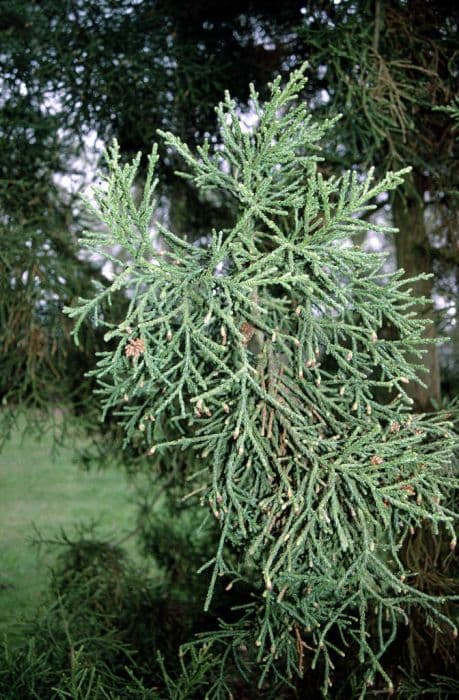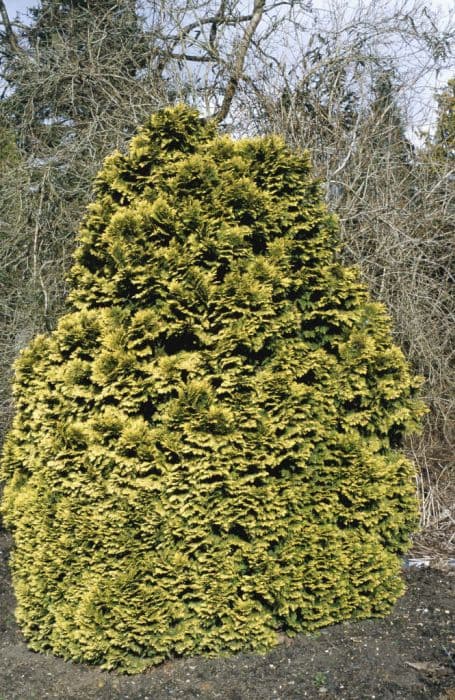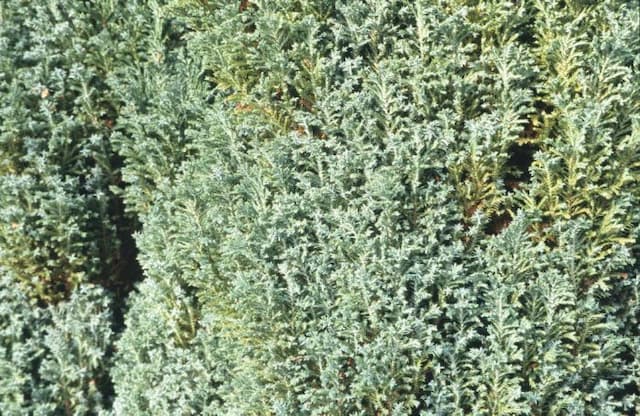Lawson's cypress 'Chilworth Silver' Chamaecyparis lawsoniana 'Chilworth Silver'











ABOUT
'Chilworth Silver' is a slow-growing medium-sized evergreen shrub of broadly columnar habit, with dense, soft sprays of bright silvery-blue, semi-juvenile foliage
About this plant
 Names
NamesFamily
Cupressaceae.
Synonyms
Lawson Cypress, Oregon Cedar, Port Orford Cedar.
Common names
Cupressus lawsoniana, Chamaecyparis lawsoniana.
 Characteristics
CharacteristicsLife cycle
Perennials
Foliage type
Evergreen
Color of leaves
Blue-green
Height
10 feet (3 meters)
Spread
8 feet (2.4 meters)
Plant type
Tree
Hardiness zones
5
Native area
North America
Benefits
 General Benefits
General Benefits- Ornamental value: The Chamaecyparis lawsoniana 'Chilworth Silver', commonly known as Lawson's cypress, has attractive blue-green foliage with white-tipped branches, providing visual interest in the landscape.
- Habitat for wildlife: It offers shelter and nesting sites for birds and other small wildlife within its dense foliage.
- Windbreak and privacy: Its thick growth habit makes it an effective windbreak and privacy screen for residential and commercial properties.
- Soil erosion control: The root system can help stabilize soil and prevent erosion on slopes or banks.
- Low maintenance: Once established, it requires minimal care, making it an easy-to-maintain option for gardeners.
- Versatile landscaping: It can be used in a variety of landscaping designs, including formal gardens, hedges, and as a specimen plant.
- Adaptive to various soils: Lawson's cypress is adaptable to different soil types, although it prefers well-drained soils.
- Drought tolerance: After establishment, it shows a good level of drought tolerance, reducing the need for frequent watering.
- Year-round interest: Being an evergreen, it provides color and structure throughout all seasons.
- Sound barrier: Its dense growth can help reduce noise pollution when planted along roads or between properties.
 Medical Properties
Medical PropertiesThis plant is not used for medical purposes.
 Air-purifying Qualities
Air-purifying QualitiesThis plant is not specifically known for air purifying qualities.
 Other Uses
Other Uses- Craft Material: The wood of Lawson's Cypress 'Chilworth Silver' is often used in intricate woodworking projects, such as model building and crafting miniature items due to its fine grain and workability.
- Ornamental Displays: Smaller branches or foliage of the plant can be used to create decorative wreaths or garlands, particularly during festive seasons for natural ornaments that provide a silvery-green accent.
- Education: Botanical gardens and educational institutions might use this plant to teach about cultivar development and genetic variations in coniferous plants, showcasing its unique coloration.
- Privacy Screens: Because of its dense foliage, Lawson's Cypress 'Chilworth Silver' can be used as a natural screening plant to provide privacy in residential gardens or patios.
- Theme Gardens: This plant is often utilized in conifer collections or silver-themed garden spaces to provide contrast with darker green foliage plants and create a monochromatic visual effect.
- Sound Barrier: The density of the foliage can help dampen noise when planted along roads or between properties, acting as a living sound barrier.
- Erosion Control: The root system of Lawson's Cypress 'Chilworth Silver' can help stabilize soil on slopes or banks, reducing erosion and maintaining landscape integrity.
- Photography: With its striking silvery-blue foliage, it can serve as an excellent subject for plant photography and help amateur and professional photographers practice capturing texture and color contrasts.
- Windbreak: In larger landscapes or farms, rows of these trees can be planted to serve as windbreaks, helping to protect other plants and reduce wind erosion.
- Urban Landscaping: The Chilworth Silver variation of Lawson's Cypress can be planted in urban settings for its aesthetic value and to bring a touch of nature into the built environment.
Interesting Facts
 Feng Shui
Feng ShuiThe Lawson's Cypress is not used in Feng Shui practice.
 Zodiac Sign Compitability
Zodiac Sign CompitabilityThe Lawson's Cypress is not used in astrology practice.
 Plant Symbolism
Plant Symbolism- Longevity: The Lawson cypress, as a coniferous evergreen, symbolizes long life and immortality as it maintains its foliage throughout the year and lives for many years.
- Endurance: Its ability to withstand cold climates and poor soil conditions represents the trait of endurance and the ability to thrive in difficult situations.
- Protection: Often planted as a hedge or a screen, the Lawson cypress can symbolize shelter and protection, providing a safe haven for wildlife and a privacy screen for humans.
- Healing: With its aromatic foliage and essential oils that have been used in traditional medicine, it also symbolizes healing and purification.
 Water
WaterThe Lawson Cypress, commonly known as the Lawson's Cypress, prefers even moisture and should not be allowed to dry out completely. It should be watered deeply once a week, providing around 1 to 1.5 gallons of water for smaller trees and up to 5 gallons for larger ones. During hot and dry periods, increase the frequency to twice a week. Overwatering and waterlogged soil can be detrimental, so ensure good drainage. Adjust the watering schedule during the winter months when the tree requires less water.
 Light
LightThe Lawson's Cypress thrives in full sun to partial shade conditions but prefers a spot with plenty of morning sunlight and some afternoon shade in hotter climates. The best location would provide unfiltered sunlight for at least six hours a day to promote dense foliage growth and a healthy plant.
 Temperature
TemperatureThe Lawson's Cypress does well in a range of temperatures, growing best within a range of 60°F to 75°F. It can survive minimum temperatures down to about -30°F and maximum temperatures up to 95°F. Protect from extreme cold winds which can cause drying and winter burn, especially in young plants.
 Pruning
PruningPrune the Lawson's Cypress to maintain its shape and density, which also helps prevent disease by improving air circulation. The best time to prune is in late winter or early spring before the growing season starts. Pruning should be done sparingly, up to once a year, removing only the dead or diseased branches and shaping gently without cutting into older wood.
 Cleaning
CleaningAs needed
 Soil
SoilLawson's Cypress 'Chilworth Silver' thrives best in moist, well-draining soil with a pH range of 5.0 to 7.0. A soil mix of peat, bark, and perlite or sand is ideal to provide the necessary drainage and aeration.
 Repotting
RepottingLawson's Cypress 'Chilworth Silver' generally requires repotting every 2 to 3 years to refresh the soil and accommodate root growth.
 Humidity & Misting
Humidity & MistingLawson's Cypress 'Chilworth Silver' prefers moderate to high humidity levels; aim for humidity levels of 40-60% for optimal growth.
 Suitable locations
Suitable locationsIndoor
Use a large pot with drainage and place it in bright, indirect light.
Outdoor
Plant in moist, well-drained soil and full sun to partial shade.
Hardiness zone
5-8 USDA
 Life cycle
Life cycleLawson's Cypress 'Chilworth Silver' starts its life as a seed, enclosed in a cone that requires exposure to a period of cold to germinate (stratification). Upon germination, the seedling emerges and begins to develop a root system and juvenile foliage, characterized by soft, feathery leaves. As it grows into a young tree, it develops scale-like adult leaves and a conical shape common to mature Lawson's Cypress, with silver-blue tinted foliage. Throughout its maturity, it produces small, round cones and continues to add height and girth. The tree can live for many decades, and even centuries, if conditions are favorable. In the final stage of its life cycle, the tree will eventually succumb to age, environmental stress, or disease, and die, returning nutrients to the soil and making room for new growth in the ecosystem.
 Propogation
PropogationPropogation time
Late winter-early spring
The most popular method of propagating Lawson's Cypress 'Chilworth Silver' is through semi-hardwood cuttings. This process typically begins in mid to late summer when the current season's growth has begun to harden but is not yet fully mature. Cuttings should be taken from healthy parent plants, with a length of about 4 to 6 inches (10 to 15 centimeters). The lower needles are removed to expose the stem, which is then dipped in rooting hormone to encourage root development. The prepared cutting is inserted into a pot filled with a mixture of peat and perlite to provide adequate drainage and aeration, ensuring that about two-thirds of the cutting is buried in the substrate. The pot is then placed in a protected environment with high humidity and indirect light. Regular misting helps maintain humidity levels while the cutting establishes roots over several weeks to months.









